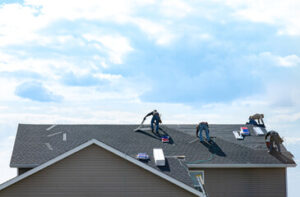A roof protects a building from rain, snow, sunlight and extremes of temperature. It can be constructed in a variety of forms.

Flat roofs can be covered with membrane and vapor barrier, and sloped roofs with shingles, slate or metal. Leaks tend to occur at penetrations such as chimneys and plumbing vents; flashing is used to prevent them.
Severe weather conditions like high winds, heavy rains, hail, snow, and ice storms can take their toll on roofing materials and cause leaks or structural damage. Taking proactive measures to enhance the resilience of your home’s roof against severe weather conditions can help protect you, your family, and your belongings from serious damage.
Various types of severe weather can impact the integrity of your roofing system, and specific roofing materials have advantages over other kinds of roofing in different climates. For example, a roofing material with a built-in protective layer offers enhanced resistance against the damaging effects of prolonged sun exposure. A waterproof underlayment can also reduce the risk of water infiltration and extend the lifespan of your roofing system.
Another common severe weather issue is debris that gets blown onto and into your home’s roof. This often includes branches, gravel, twigs, and other objects. This debris can cause punctures, dents, and other defects that can compromise your roof’s ability to resist water infiltration. Investing in regular inspections and maintenance and trimming trees near your home can minimize the risk of debris impacting your roof.
Hailstorms are also a common problem for homeowners in the Bay Area, and this type of severe weather can wreak havoc on roofing systems. This is because hailstones, ranging from the size of small pellets to the size of softballs, can pelt your roof with force. The hailstones can cause dents, pitting, and other damage that can compromise your roof’s ability to defend your home from water infiltration.
If you’re in an area prone to severe hailstorms, it might be worth investing in a foam roof that is impact-resistant and self-healing. The specialized construction of these types of roofing materials can significantly reduce the damage that hail can cause to your roof. It can also save you money on roof repairs and replacements by reducing the risk of major damages. Moreover, it’s always wise to purchase extra flood or hurricane insurance that covers the cost of repairing and replacing your roof in case of severe weather events.
Durability
Your roof is a vulnerable part of your home, but it’s also an important investment. A well-performing roof protects the interior and exterior of a structure from water, wood rot, mold and other damage. The average cost to reroof a home is approximately $9,052. Therefore, it’s crucial to consider durability when selecting a roofing material.
According to a report by the Environmental Protection Agency, roof leaks can cause significant structural damage to building materials and furnishings. They can also result in mold growth, which can impact indoor air quality and lead to respiratory problems for the building occupants. Durability is an essential attribute to look for in roofing materials and systems because a high-performing roof lasts longer, which reduces the need for costly repairs and replacements.
In addition to preventing leaks, a durable roofing system provides insulation, which can help a home stay cooler in the summer and warmer in the winter. It also helps to reduce energy costs. Additionally, durable roofing materials are able to withstand the elements, including strong winds and hail, which can be a major challenge in the Midwest.
There are many different roofing materials to choose from, and each one has its own benefits and drawbacks. For example, wood shakes offer a rustic charm and good insulating properties but require more maintenance and are susceptible to fire and rot. Conversely, metal roofing offers a long lifespan but may be expensive and more difficult to install than some other options.
A roof’s longevity depends on the material used, the installation method and the weather conditions. Most asphalt shingles last 15 to 20 years, while cement and clay tiles can last up to 50 years. Slate roofs have one of the longest lifespans, lasting up to 100 years. However, this type of roof is extremely heavy and requires a home to be reinforced by a structural engineer before being installed.
Despite the challenges, there are plenty of ways to maximize a roof’s durability, including installing proper flashing (material that seals around penetrations like vents or skylights), ensuring a properly functioning chimney and having a professional perform a regular inspection and maintenance routine.
Aesthetics
Whether sheltering a commercial or residential structure, roofs have an architectural significance that goes beyond their function. They can be a canvas for design, contributing to the overall beauty of a building or establishing its personality. For instance, pagoda-style roofs in Asia symbolize wealth and prosperity while Mediterranean-style clay tile roofs evoke rustic charm. As a result, homeowners and business owners often take aesthetics into account when choosing roofing materials and styles.
Aesthetics when it comes to roofing play a significant role in enhancing the exterior look of buildings, adding curb appeal and boosting resale value. It is important for homeowners to consider the visual impact of their home’s roof when undergoing a roof replacement project.
One of the most important aspects of a roof’s aesthetic is its color. A variety of colors are available, including earthy tones that blend seamlessly with natural landscapes and the architectural style of a home, as well as more bold options that can create a dramatic impression. Additionally, the shape and pitch of a roof can also influence its aesthetic. A steeper roof adds drama to a structure while a flat roof offers a sleek and modern appearance.
Adding or removing accessories like skylights, dormers and chimneys can also help enhance the aesthetic of a roof. These elements should be thoughtfully incorporated into the roof’s design, and carefully coordinated with the roofing material and color to create a harmonious aesthetic. Furthermore, integrating green roofing or solar panels into the roof’s design can offer environmental benefits as well as enhance the home’s visual appeal.
Energy Efficiency
As the world moves towards sustainable living, it’s important for businesses and homeowners to consider energy efficiency when choosing roofing. This means a roof that reflects the sun’s heat instead of absorbing it, helping to keep a building cool. It also means a roof that keeps warmth inside in the winter, decreasing the need for HVAC systems and saving money on utility bills.
Energy efficient roofing is available in a variety of styles and materials. Some of the more popular options include shingle roofing that has a high Solar Reflectance Index and thermal emittance rating, as well as metal and tile roofs. These types of roofs can help reduce energy costs significantly. In some cases, homeowners can even qualify for credits and rebates when they install an energy-efficient roof.
Many factors influence a roof’s energy efficiency, including its color and the use of reflective coatings. Other factors include attic ventilation and insulation. A properly installed and maintained roof with energy-efficient roofing material can decrease the need to run your HVAC system in summer, which helps save on utility bills.
A roofing professional can help you choose an energy-efficient roof that will provide long-term benefits and increase the value of your property. They can also ensure that your new roof meets all of the required manufacturing and installation warranties so that you don’t have to worry about any issues down the road.
A roof is a critical component of any building, providing weather protection and adding aesthetic appeal. However, it is not something that can be taken for granted. It is crucial to protect your home or business from the elements with a well-designed and maintained roof.
